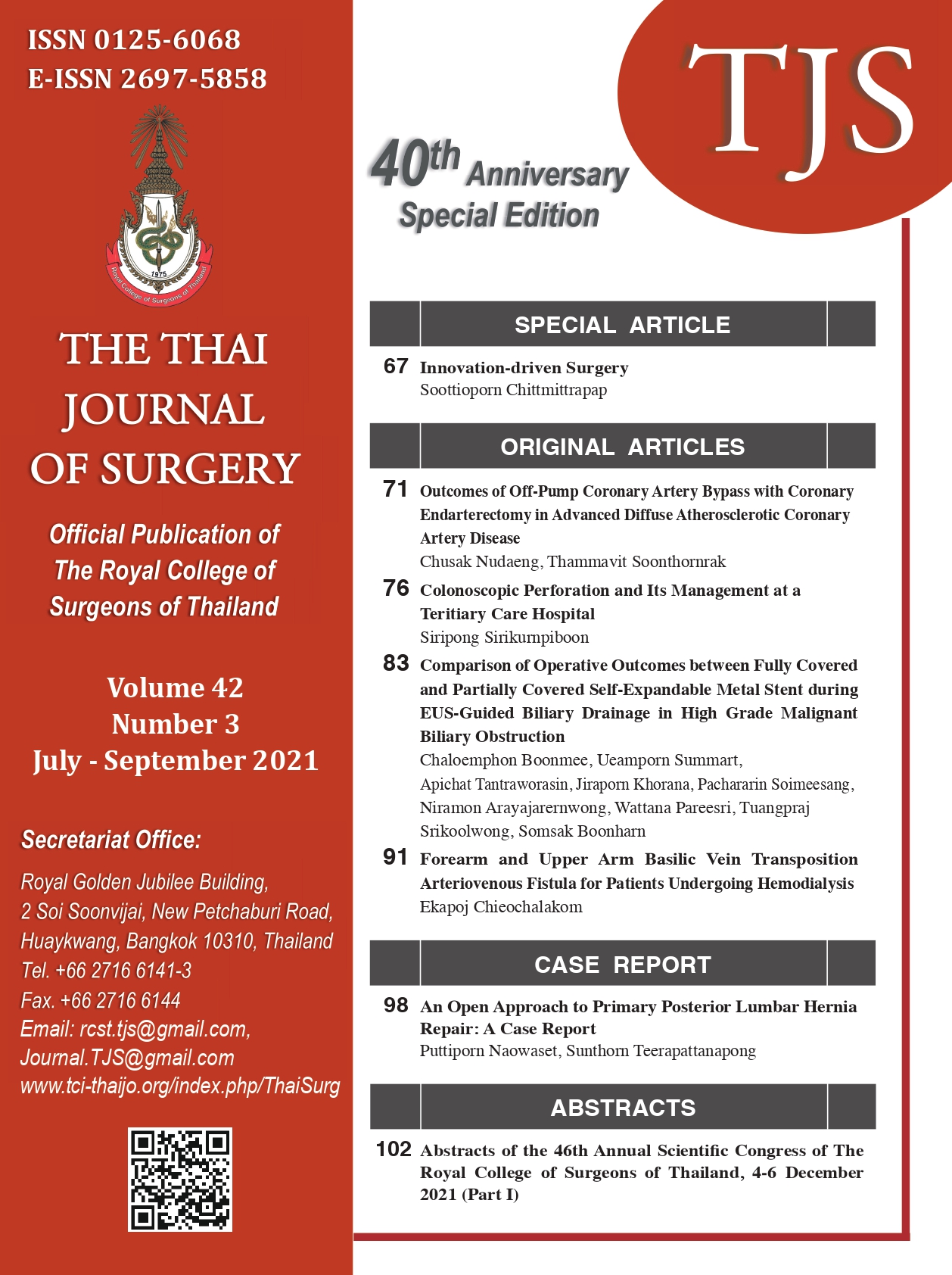Forearm and Upper Arm Basilic Vein Transposition Arteriovenous Fistula for Patients Undergoing Hemodialysis
Keywords:
Vascular access surgery, Basilic vein transposition, HemodialysisAbstract
Objective: The aim of the present study was to evaluate the functional patency of the standard vascular access surgery and basilic vein transposition (BVT) arteriovenous fistula (AVF) in a single institution.
Methods: We reviewed cases of vascular access surgery performed between September 1, 2011 and August 31, 2019. Demographic and postoperative surveillance data were collected. BVT patients were either found unsuitable for or had failed any of the direct AVF options prior to transposition surgery.
Results: A total of 561 patients (325 men and 236 women) underwent vascular access surgery in the 9-year period. The mean age was 58.8 ± 14 years. The causes of chronic renal failure were diabetes (43%) and hypertension (86%). The mean follow-up duration was 28.6 ± 22.9 months. A total of 75 patients (41 men and 34 women) underwent BVT. The mean fistula maturation time was 1.9 ± 1.7 months in upper arm BVT and 2.6 ± 1.2 months in the forearm BVT. The maturation rate was 90% in the upper arm BVT and 86% in the forearm BVT. No bleeding, thrombosis, failure, pseudoaneurysm, or rupture occurred. The mean follow-up time in the BVT group was 31.6 ± 19.7 months. BVT functional patency assessed at 12, 24, and 36 months was 91%, 83%, and 72%, respectively, in the upper arm, and 76%, 51%, and 45%, respectively, in the forearm.
Conclusion: BVT is an alternative vascular access surgery with excellent initial maturation and patency rates, and should be considered in patients undergoing hemodialysis with primary failure of the fistula or naive veins not suitable for surgery. It is less expensive compared with the use of polytetrafluoroethylene grafts for secondary access.
References
Brescia MJ, Cimino JE, Appel K, Hurwich BJ. Chronic haemodialysis using venipuncture and a surgically created arteriovenous fistula. N Engl J Med 1966; 275:1089-92.
Foundation NK. KDOQI clinical practice guidelines and clinical practice recommendations for 2006 updates: hemodialysis adequacy, peritoneal dialysis adequacy and vascular access. Am J Kidney Dis 2006;48(Suppl 1):1–322.
Dagher F, Gelber R, Ramos E, Sadler J. The use of basilic vein and brachial artery as an A-V fistula for long-term haemodialysis. J Surg Res 1976;20:373-6.
Oliver MJ, McCann RL, Indridason OS, et al. Comparison of transposed brachiobasilic fistulas to upper arm grafts and brachiocephalic fistulas. Kidney Int 2001;60:1532-39.
Coburn MC, Carney WI Jr. Comparison of basilic vein and polytetrafluoroethylene for brachial arteriovenous fistula. J Vasc Surg 1994;20:896-902.
Rivers SP, Scher LA, Sheehan E, et al. Basilic vein transposition: an underused autologous alternative to prosthetic dialysis angioaccess. J Vasc Surg 1993;18:391-6.
Kalman PG, Pope M, Bhola C, et al. A practical approach to vascular access for hemodialysis and predictors of success. J Vasc Surg 1999;30:727-33.
Gibson KD, Gillen DL, Caps MT, et al. Vascular access survival and incidence of revisions: a comparison of prosthetic grafts, simple autogenous fistulas, and venous transposition fistulas from the United States Renal Data System Dialysis Morbidity and Mortality Study. J Vasc Surg 2001;34:694-700.
Sidawy AN, Gray R, Besarab A, et al. Recommended standards for reports dealing with arteriovenous hemodialysis accesses. J Vasc Surg 2002;35:603-10.
Hakaim AG, Nalbandian M, Scott T. Superior maturation and patency of primary brachiocephalic and transposed basilic vein arteriovenous fistulae in patients with diabetes. J Vasc Surg 1998;27:154-157.
Wolford HY, Hsu J, Rhodes JM, et al. Outcome after autogenous brachial-basilic upper arm transpositions in the post-National Kidney Foundation Dialysis Outcomes Quality Initiative era. J Vasc Surg 2005;42:951–56.
Choi HM, Lal BK, Cerveira JJ, et al. Durability and cumulative functional patency of transposed and nontransposed arteriovenous fistulas. J Vasc Surg 2003;38:1206–12.
Fitzgerald JT, Schanzer A, Chin AI, et al. Outcomes of upper arm arteriovenous fistulas for maintenance hemodialysis access. Arch Surg 2004;139:201–8.
Cantelmo NL, LoGerfo FW, Menzoian JO. Brachiobasilic and brachiocephalic fistulas as secondary angioaccess routes. Surg Gynecol Obstet 1982;155:545-8.
Rivers SP, Scher LA, Sheehan E, et al. Basilic vein transposition: an underused autologous alternative to prosthetic dialysis angioaccess. J Vasc Surg 1993;18:391–7.
Hill BB, Chan AK, Faruqi RM, et al. Keyhole technique for autogenous brachio-basilic transposition arteriovenous fistula. J Vasc Surg 2005;42:945-50.
El Mallah S. Staged basilic vein transposition for dialysis angioaccess. Int Angiol 1998;17:65-8.
Patel ST, Hughes J, Mills JL Sr. Failure of arteriovenous fistula maturation: an unintended consequence of exceeding Dialysis Outcome Quality Initiative guidelines for hemodialysis access. J Vasc Surg 2003;38:439-45.
Downloads
Published
How to Cite
Issue
Section
License
Articles must be contributed solely to The Thai Journal of Surgery and when published become the property of the Royal College of Surgeons of Thailand. The Royal College of Surgeons of Thailand reserves copyright on all published materials and such materials may not be reproduced in any form without the written permission.



